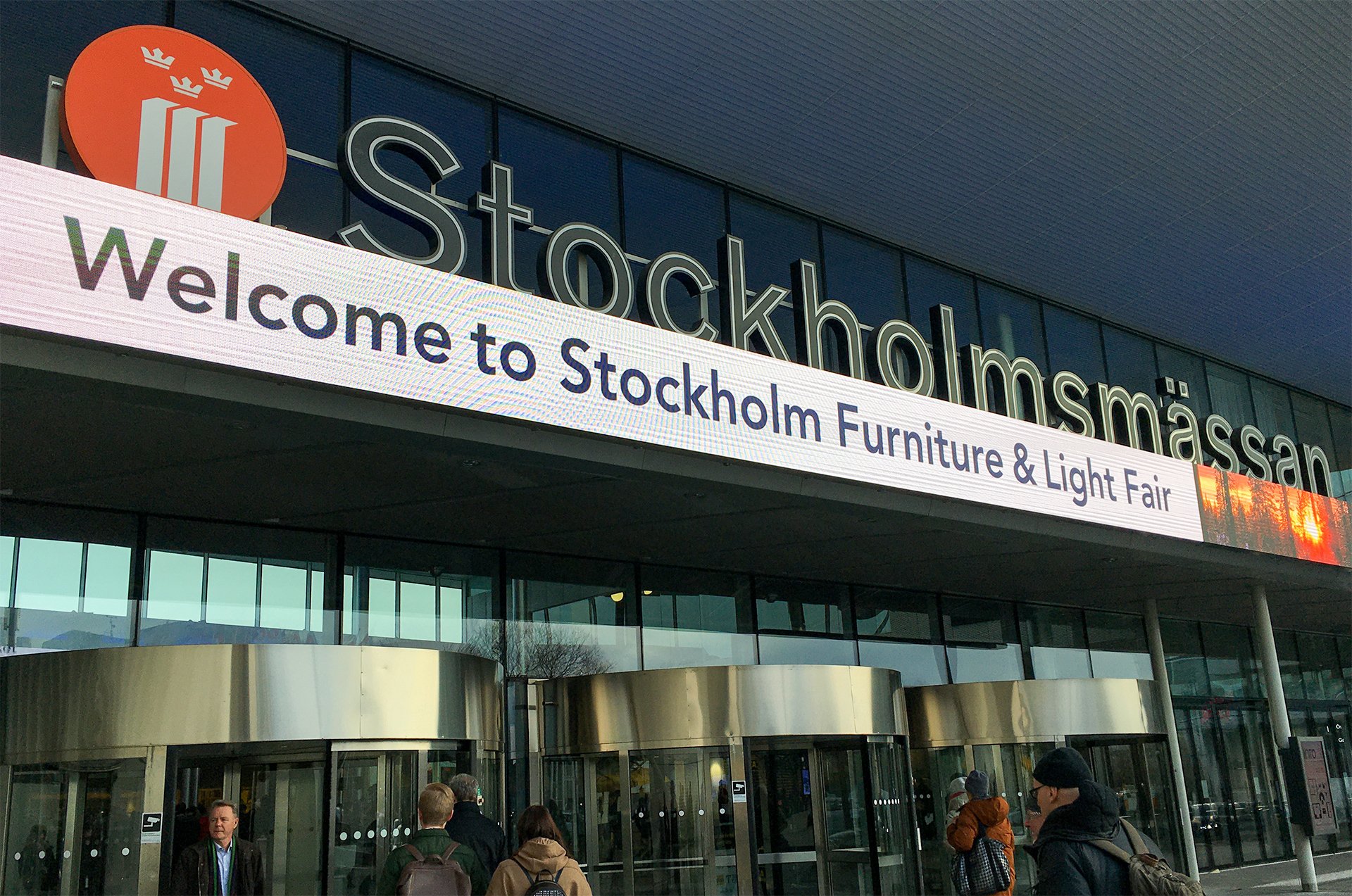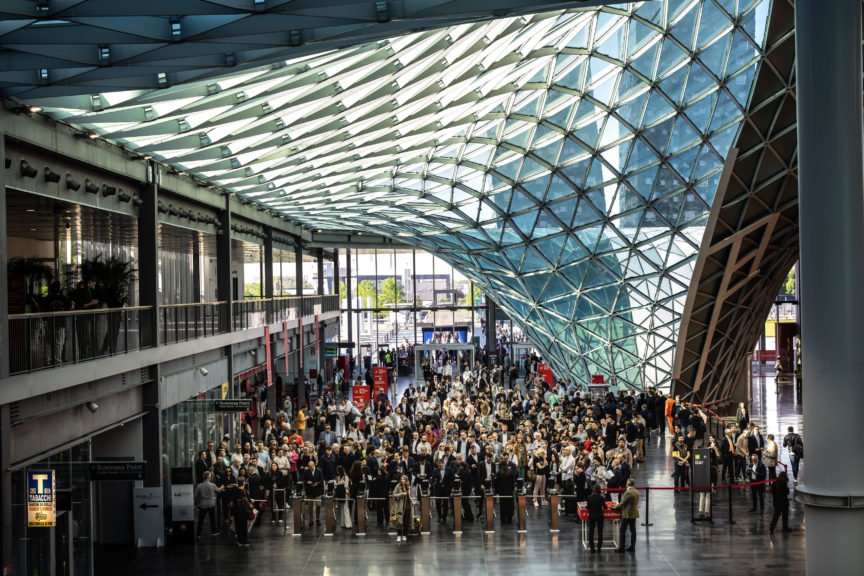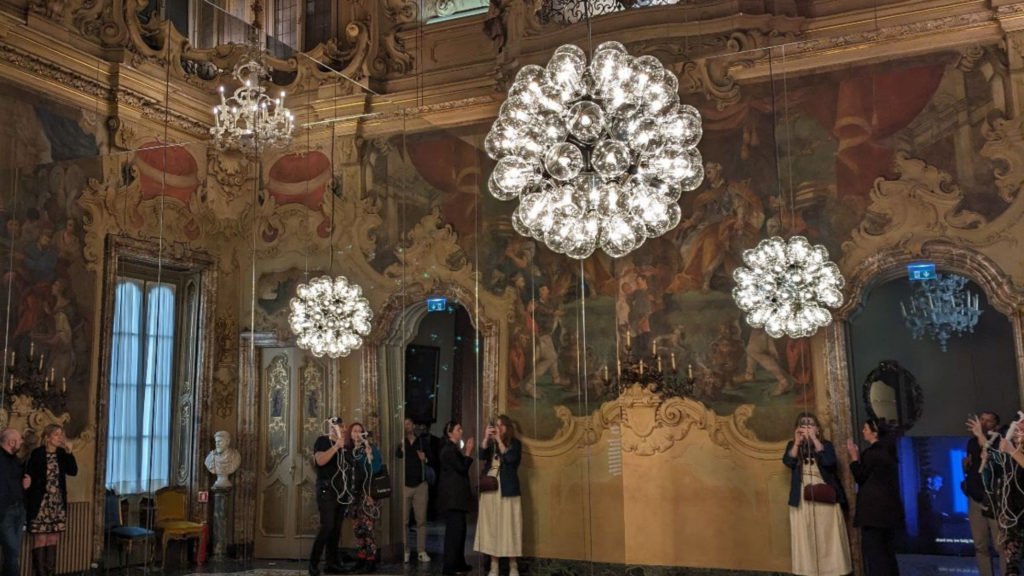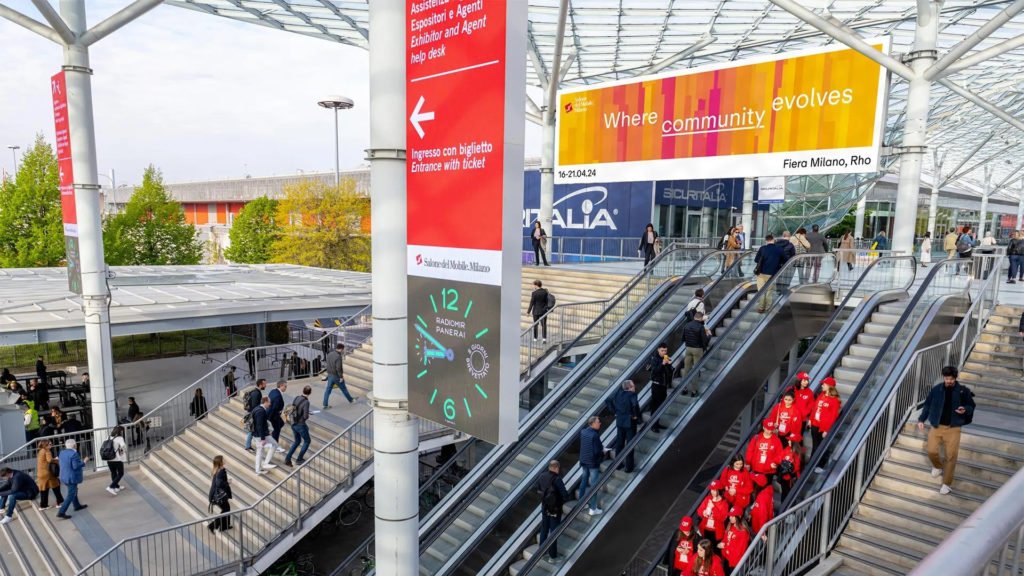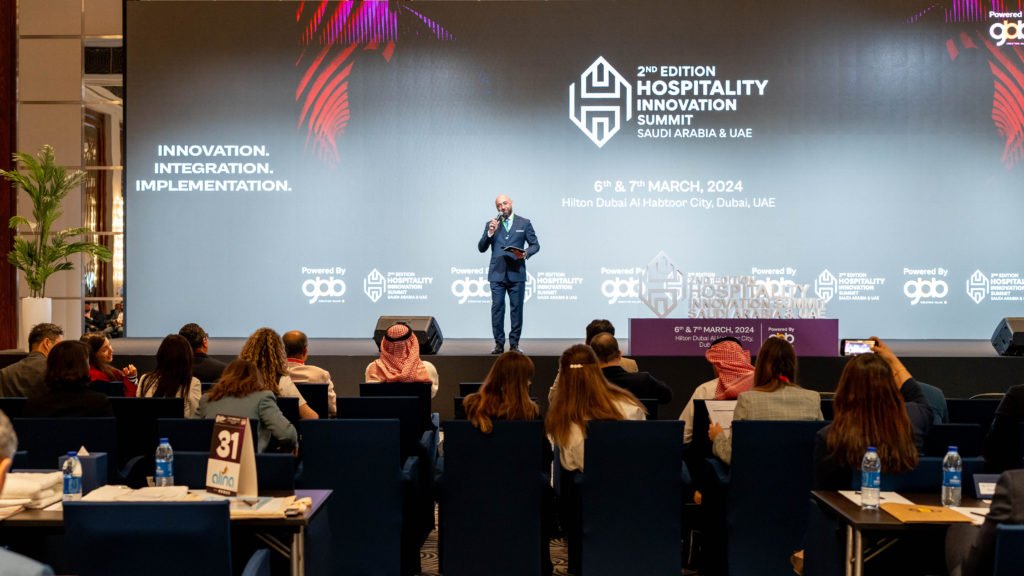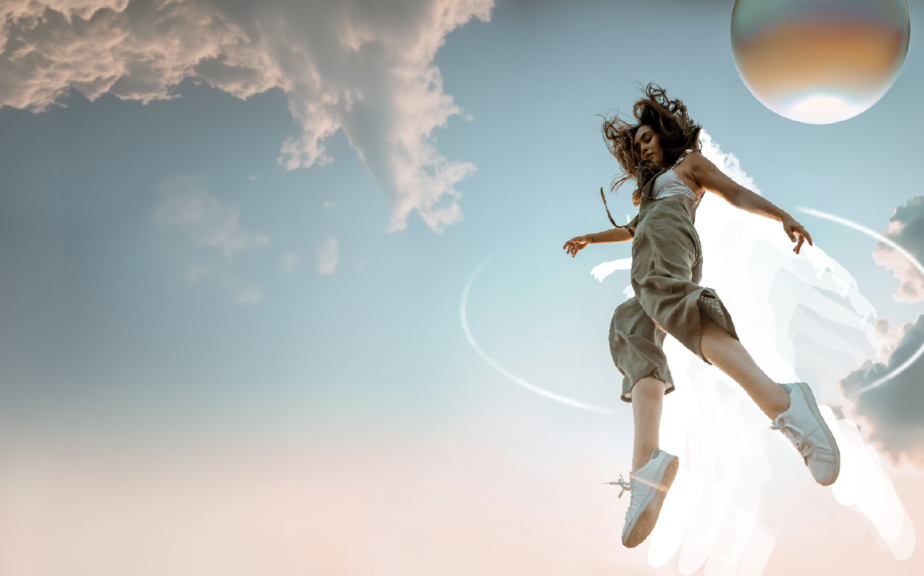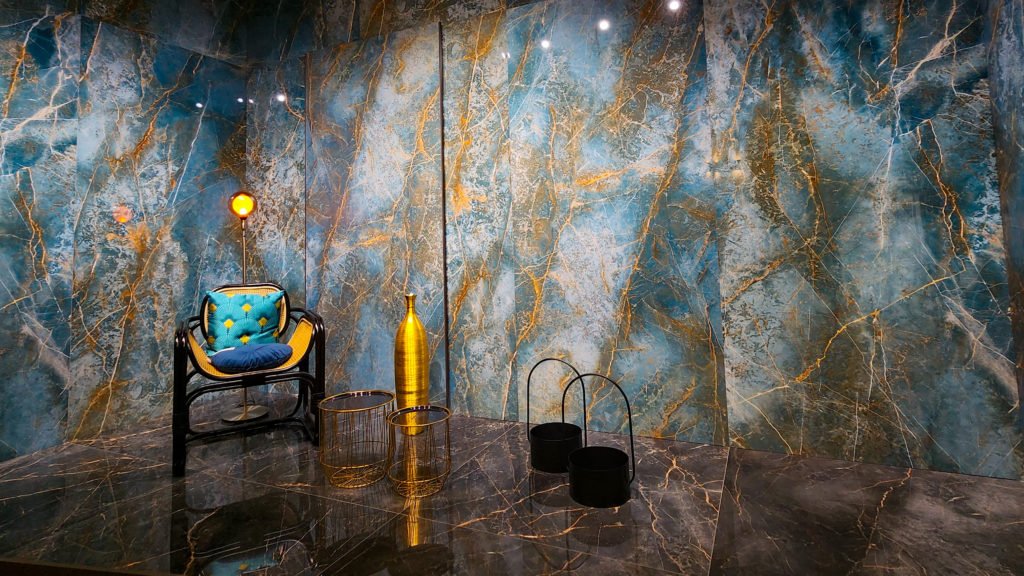Each year during the month of February, the Swedish capital hosts its illustrious Stockholm Design Week, attracting the who’s who of the global design industry. At the heart of the week-long series of events, that sees the city buzzing with pop-ups, exhibits, parties and more, is the Stockholm Furniture & Light Fair. The historic exhibition, which helped elevate Scandinavian design to international prominence, celebrated its 70th anniversary this year. We visited the fair, wading through the 700 or so exhibitors, and explored the latest trends, innovations and environmental solutions. Here’s our lowdown on the best that the show had to offer.
Homage To Scandinavian Design
With 80 percent of exhibitors being Scandinavian by origin, the exhibition spoke strongly to modern regional aesthetics, namely minimalism, clean lines, style and quality, and of course, lots of wood. In the 1950s, as living spaces became smaller, Swedish design exploded in popularity and has since fuelled demand for functional furniture, as demonstrated by the global IKEA phenomenon. Fear not, however, there was not a single flat pack in sight at the fair!
To mark the occasion of its 70th anniversary, the exhibition featured an homage to Scandinavian aesthetics, curated by design journalist Dan Gordan. A showcase of quintessential furnishings from every decade from the 1950s onwards, each piece was selected for its iconic influence on Scandinavian furniture design and continued relevance today. Among them, the Ababesk chair by Folke Jansson, the Etcetera Lounge Chair by Jan Ekselius, and the Emma armchair by Färg & Blanche, faithfully represented Scandinavian period pieces from the 50s, 70s and 2010s respectively. Despite changing trends throughout the decades, each piece reflected a Scandinavian appreciation for functional design that blends harmoniously into the environment and offers a sense of timeless minimalism, so clearly associated with local tradition.
Above: Jan Ekselius, Folke Jansson and Färg & Blanche
Contemporary Scandinavian Design
The Scandinavian design legacy was clearly present at the show amongst the crème de la crème of regional exhibitors. Among them was Swedese, the brainchild of brothers Yngve and Jerker Ekström, who helped elevate Scandinavian design onto the international playing field. Responsible for the Lamino Easychair, created in 1956, the chair was voted the “20th Century’s Best Swedish Furniture Design” at the turn of the millennium, and continues to be manufactured globally today. From lamps to vases, trays and mirrors, the brand shone a light on its latest interior accessories collection, that added a sense of playful well-being.
The Figur Table, designed by Björn Sundelin for a university, was an especially standout piece, its curved, spine-like table leg made to resemble the silhouette of a student sitting on a bench. Featured in an ash veneer, the light wooden material is a favourite among regional designers, bringing lightness into the home when winters are typically long and dark. Other notable pieces were the Anna Vase, inspired by the ever-changing nature of the natural world around us, and the Comma series, featuring a tray and mirror, which celebrates spherical shapes. Across the collection, soft curved edges and lines were apparent throughout.
Another award-winning brand with roots in the same era is String Furniture. Born of a design competition launched in 1949, the String shelving system, created by couple Nils and Kajsa Strinning, was awarded the gold medal at the Triennale in Milan (1954). A design standing the test of time, the iconic shelving system is easy to assemble, versatile and adaptable. The latest interpretation of the design is the String Pocket Metal. Created for durability, it is perfectly suitable anywhere one might require shelving, including the kitchen through to the bathroom. In addition to the darker classic shades, the latest collection is now available in a bright neon orange version.
Other noteworthy products included The Pair side tables from up-and-coming Danish brand, Möbel. The contrasting tables, one made with a ceramic, high-gloss finish, the other with powder-coated steel, are of an overlapping solid void design, allowing them to be paired and arranged to meet alternating needs. ATBO’s Cocoon Chair was another eye-catcher. A timeless lounge chair for private and public spaces, it finds its inspiration in 1960s modernism. The chic lounge, made from rattan fabric placed within a curved, wooden silhouette for an ultra-inviting effect, blurs the lines between furniture and architecture.
Above: String, Swedese, Mobel, Atbo
Colour Trends
In the face of growing technological fatigue and ever-increasing detachment from the simplicity of life, our need to reconnect with the natural environment that surrounds us has influenced the colour palettes of the season. From earthy tones, such as pinks and reds, to richer blues and greens, designers are inviting the natural elements into our spaces to encourage a sense of well being and quiet interior reflection. With the Pantone Colour of the Year a classic blue, reminiscent of calming blue oceans, this was no surprise. Vibrant yellows also made an appearance.
Speaking to these naturally influenced colour trends, Italian brand REISS PETTERSON, which specialises in terrazzo floors, had a beautiful selection of tiles on show in a variety of hues from pinks to greys, greens and blues. The collection also featured its range of ‘Terrazzo Top Tables’. Created with small spaces in mind, these tables were on display in a variety of heights, and a combination of pink or green frames and yellow or neutral coloured tops.
Italian brand PEDRALI’s stand, created by Milanese architecture studio Calvi Brambilla, also featured eye-popping pinks, reds and greens. The brand’s Tribeca seating collection was featured at the show in a gorgeous, pastel pink hue. Inspired by patio chairs of the sixties, and made from woven cord and steel, the design is in the running for the prestigious Compasso d’Oro Awards 2020. Another Pedrali product highlight was the barstool from the Folk collection, showcased in a peaches-and-cream back and contrasting vibrant red cushion cover. The collection, designed to be disassembled with ease for recycling purposes, reflects the brand’s commitment to environmental sustainability.
Striking reds juxtaposed against paler pinks was a trend also noted on yet another Italian designer’s stand, Magis, who showcased their Traffic collection of sofas and lounges. Designed by Konstantin Grcic, the series consists of an exposed steel frame base featuring intersecting lines, contrasted against cushion seating.
Above: Reiss Petterson, Pedrali, Magis
Modulyss joined hands with wood and plastic floor manufacturer, Kährs’. Their stand showcased a combination of wood, LVT and carpet tiles, and spoke to the colour trends of the season. The brands highlighted their latest Lavish Rust, Calming Nature and Luscious Yellow collections comprising earthy tones, tranquil greens and uplifting yellows respectively. Many similar hues were also spotted on the Baux stand.
Reds and yellow accents found their way into lighting collections too. Swedish brand Umage showcased its Clava Dine lampshades (an industrial yet retro spherical design made from aluminium and featuring perforated holes) in both hues. Meanwhile, against the backdrop of Saas Instruments’ black exhibition stand, the striking Routa design light, conceptualised by Martin Bergström, stood out in a deep red hue.
With far too many stands and products to mention, it’s fair to say you’ll be seeing a lot more of these natural, earth tones across the design sphere over the course of the year.
Above: Modulyss & Kährs, Baux, Umage, Saas Instruments
The Changing Face of the Workplace
One of the overarching themes permeating the show this year was the changing nature of office spaces. Influenced by the rise of several megatrends brought about by our always-on, digitally connected culture – a topic addressed in-depth during the show by consumer retail expert Louise Byg Kongshom – what we require today of our workspaces has fundamentally changed. Technology has disrupted traditional work habits. Thanks to digital devices, the worker has become increasingly mobile, facilitating the growing popularity of working trends, such as remote, co-working and hot-desking. Frequently, alternative spaces are used for remote working, and offices have had to become more flexible. Meanwhile, faced with constant distractions from co-workers, noise and digital devices, individuals are finding it increasingly difficult to focus in their work environment. In response, contemporary designers are taking a human-centric approach, helping to redefine the traditional workplace.

The Need for Focus
Addressing these needs, Swedish brand Götteson, showcased its latest ‘Room Within A Room’ at the exhibition, the Open Half Hut in a trending earthy yellow. The space offers a private enclosure, while not being entirely cut off from the surrounding environment. Inspired by the board game Monopoly, the Hut takes its shape from the game’s house and hotel shaped pieces. Usable as an individual workspace, meeting room or relaxation space, its sound absorbing material encourages focus in a busy environment. Created with the office in mind, the Hut could also just as well be at home in a hotel lobby, catering for business professionals on the move.
Estonian upholstered furniture manufacturer, Softrend, spoke to this very message. According to the company, 95 percent of people say that they struggle to focus at work. With this in mind, their one-person, sound-absorbing sofa, August, was on display at the show with an earthy pink PVC backrest, contrasted against a classic blue seating. The overhead backrest and high panels on either side provide a considerable sense of privacy, making it ideal for phone calls or meetings, and creating zones within a space. European brand, Nowy Styl Group, headquartered in Poland, also showcased similar solutions with its award-winning Play & Work solution. The collection was designed by Gernot Oberfell and Jan Werte, alumni of the Ross Lovegrove, a master and designer of the Apple iMac, and featured modular design, high upholstered panels, and sound absorbing qualities .
Above: Götteson, Softrend, Nowy Styl
The Need for Silence
Finish company, Framery, demonstrated the growing use of soundproof booths in the office space. Available in three sizes, Framery’s trendy office pods offer privacy for one to six persons, depending on the model. Inspired by the elemental nature of the simple cube, their traditionally minimalist design consists of a metal frame and laminated glass from floor to ceiling on either side. The booths, which provide space to enable focus, can be used for video conferencing, meetings, or simply some quiet time. The pods are customisable with 13 different colour options for the frame, and 15 for the interiors, along with optional built-in screens. The company has become so popular that its profits grew from 1 to 60 million euros in just five years, and has entered the FTSE 1000. And their pods may have been designed for the hectic office, but they certainly provided us with the perfect sanctuary on a noisy exhibition floor!
Above: Framery
A Growing Awareness of Acoustics
As all these brands demonstrated, the consideration of acoustics has become crucial to interior designers. BAUX, manufacturer of sustainable construction materials, also launched their ‘Book of Acoustics’ at the show. Written by the experts and aimed towards architects, interior designers and anyone else with a quiet interest, the book provides an overview and guide to better understanding the science, history and impact of acoustics. The brand’s exhibition stand, titled The Temple of Sound, was hard to miss, as it showcased its selection of brightly coloured, sustainably made, acoustic tiles, designed to absorb sound and soften interiors. Coming in an assortment of shapes and colours, these tiles can be used to create interesting patterns, ideal for office spaces, educational institutions and even healthcare settings.
Above: Baux
The Growing Need for Flexibility
No longer chained to our desks for eight hours a day, thanks to the use of mobile devices, the boundaries between work, public and private spaces have eroded. We share spaces more and more, and in response, architects, designers and manufacturers have noted greater demand for multi-functional products. Simultaneously, these multifunctional products must also come with an affordable price tag, in light of increasing rents plus space constraints in global cities.
Understanding these demands, Arper showcased its Cila Go seating collection. Designed for an educational environment, the Cila Go chair comes with options for a base, and doubles as additional seating plus storage. With co-working spaces and individual well-being in mind, the Pedrali stand featured its height adjustable Arki-Table with integrated Wi-Fi technology, making it fully adjustable via an app! In a similar vein, established office interiors specialist, Interstuhl, displayed their UPis1 stool, designed for quick and easy, spontaneous movement between conversations, brainstorms, workshops, meetings and more, allowing for greater mobility and flexibility.
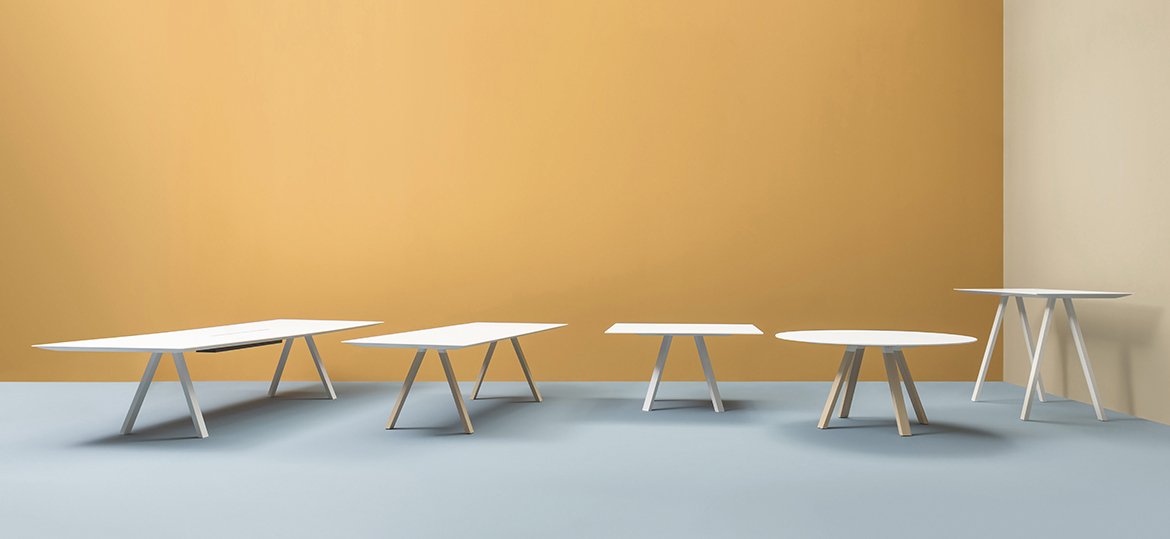
Top: Pedrali, Above: Interstuhl and Arper
The Need for Creativity
The decline of the office hierarchy has created higher demand for dynamic spaces that foster collaboration and innovation. This was a common theme among exhibitors who focused on products that would aid a sense of playfulness in the office.
Inviting movement into an otherwise desk-based environment to encourage creativity, both Interstuhl and new market player Playoffice, showcased swings designed for the office. Playoffice’s eye-catching version in a dusty pink is a new product for the Swedish brand. Interstuhl launched HUB, their version of flexible, modular work systems that cater to both individual and collaborative situations.
The desire to return to nature was reflected by the growing use of wood in the workplace. Wood has been appreciated for aiding a sense of well-being in the office, and featured in conference and meeting tables at the show. The Herman Miller stand gave us a preview of the Civic Table, designed by Sam Hecht and Kim Colin, in a wood finish. Addressing the need for multifunctionality, the table is designed for multiple uses and spaces, and features curved edges to encourage cooperation.
Above: Interstuhl, Playoffice, Herman Miller
Sustainability at the Heart
With Swedish born Greta Thunberg becoming the voice of an entire generation on the issue of climate change, it’s no surprise that sustainability was a core focus at the Stockholm Furniture and Light Fair. While environmental sustainability is already in the DNA of many Scandinavian brands, the pressure on the industry to live and breathe green is greater than ever. Though environmental sustainability is no new trend to the Northern European’s, transparency is now critical as consumers increasingly hold brands responsible that are not true to their word. In response, brands at the show focused on highlighting their sustainability efforts, including MAZE, Baux, Bolon, Swedese, Kvadrat, Interface and many more.
Interface announced its Mission Zero policy achievement, a target the company set for itself in 1994. The goal of carbon neutrality was attained by the brand last year. This manufacturer of carpet tiles and other floorings, including luxury vinyl tile (LVT), measures its impact using a combination of metrics, from water usage all the way through to transportation. At the show, the brand exhibited its Look Both Ways collection of tiles, designed to encourage playfulness, and available in several shades of grey, classic blues, earthy red tones and a mustard yellow. Interface’s next environmental goal is to achieve negative carbon status by 2040.
As far as green credentials go, MAZE is a brand that was created with its environmental impact in mind. Committed to ‘honest manufacturing, good working conditions, recycled materials, and a strict no air freight policy, the brand lives by what it calls ‘Slow Production’ – a promise to never over-produce, but rather cater to demand. Its stunning collection features interior accessories, from wall hooks to shelves, and other storage solutions designed for a lifetime. Standout pieces include the Pythagoras wall bracket for its shelving units, based on the Pythagorean equation of angles.
Meanwhile, Götteson displayed their process of working with recycled plastic bottles, which are then used throughout their product line, including the acoustic installations. In similar product innovation, Baux showcased their Acoustic Pulp Tiles, the world’s first 100 percent, bio-based, acoustic panels. And Arper launched the latest version of their Juno Eco chair. This newest edition is made with 75 percent recycled, post-industrial, plastic materials. As the brand seeks to become greener, it is increasingly committed to providing information on each product’s carbon footprint, the recycled materials used in its making, as well as future recyclability.
With numerous green approaches, innovations and solutions showcased to deal with the environmental challenges we face, there was no shortage of green inspiration at the exhibition. The show demonstrated how world-leading brands continue to deliver beautiful aesthetics without sacrificing on quality, and all the while still being kind to the planet.
Above: Interface, Maze, Arper and Kvadrat
‘The Art of Performance’ – Nominee for Best Stand
When stepping into the Bolon stand, eloquently named ‘The Art of Performance’, the experience was quite unlike any other at the show. Created by Snarkitecture, a New York-based design studio, the stand featured strong architectural influences. It demonstrated an evident appreciation for the broader arts but, in the end, fundamentally transcended all artistic boundaries.
Designed to encourage visitors to interact and engage with their surroundings, Bolon’s stand consisted of a labyrinth of rooms and doorways, drawing visitors in and along a journey. The experience of entering through the maze-like space created a sense of mystery and excitement, as one discovered what was around the corner. Playing with perspectives, the design was a clever way of focusing on the importance of design beyond what the eye can immediately see, which aptly spoke to the depth, tactility and intricacies of Bolon’s woven flooring.
Bolon demonstrated how easy it was to remove stains from its flooring, an exercise that was both interactive and engaging. And in terms of its green credentials, the brand showed its recycling process. Highlighting how it manages waste production through a process of shredding, Bolon not only recycles its waste, but also reuses that of other companies across its entire range of innovative flooring solutions. Thus their stand aptly represented the brand’s core values – designability, sustainability, cleanability and durability.
Above: Bolon
Doshin Levien for Kvadrat
Design studio Doshi Levien were the guests of honour at the fair this year. Consisting of British-Indian couple Jonathan Levien and Nipa Doshi, the studio teamed up with Danish textile company Kvadrat to create their new curtain Maya. Among the brand’s diverse range of colourful and eye-catching fabrics, hung the Maya, high above us at the Kvadrat exhibition stand. The curtain takes its name from the Hindi word for ‘illusion’ and is inspired by the Indian sari, a flowing fabric that celebrates movement and changing perspectives, and interacts beautifully with light and shadows to create ever-changing shapes. From the choice in material to the consideration of the way the curtain interacts with its environments, Doshi Levien studio’s design sensibilities, which draw on various artistic practices, is clearly visible in this creation.

